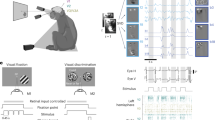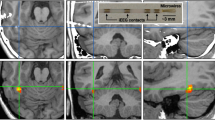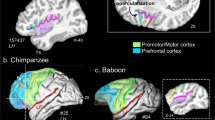Abstract
In the ventrolateral frontal lobe of the human brain there is a distinct entity, cytoarchitectonic area 44 (Broca's area), which is crucial in speech production1,2,3,4. There has been controversy5,6 over whether monkeys possess an area comparable to human area 44. We have addressed this question in the macaque monkey by combining quantitative architectonic analysis of the cortical areas within the ventrolateral frontal region with electrophysiological recording of neuron activity and electrical intracortical microstimulation. Here we show that, immediately in front of the ventral part of the agranular premotor cortical area 6, there is a distinct cortical area that is architectonically comparable to human area 44 and that this monkey area 44 is involved with the orofacial musculature. We suggest that area 44 might have evolved originally as an area exercising high-level control over orofacial actions, including those related to communicative acts, and that, in the human brain, area 44 eventually also came to control certain aspects of the speech act.
This is a preview of subscription content, access via your institution
Access options
Subscribe to this journal
Receive 51 print issues and online access
$199.00 per year
only $3.90 per issue
Buy this article
- Purchase on Springer Link
- Instant access to full article PDF
Prices may be subject to local taxes which are calculated during checkout




Similar content being viewed by others
References
Penfield, W. & Roberts, L. Speech and Brain Mechanisms (Princeton Univ. Press, Princeton, New Jersey, 1959)
Rasmussen, T. & Milner, B. in Cerebral Localization (eds Zulch, K. J., Creutzfeldt, O. & Galbraith, G. C.) 238–257 (Springer, Berlin, 1975)
Ojemann, G. A., Ojemann, J. G., Lettich, E. & Berger, M. S. Cortical language localization in left, dominant hemisphere. An electrical stimulation mapping investigation in 117 patients. J. Neurosurg. 71, 316–326 (1989)
Duffau, H. et al. The role of dominant premotor cortex in language: a study using intraoperative functional mapping in awake patients. Neuroimage 20, 1903–1914 (2003)
Rizzolatti, G. & Craighero, L. The mirror-neuron system. Annu. Rev. Neurosci. 27, 169–192 (2004)
Matelli, M., Luppino, G., Geyer, S. & Zilles, K. in The Human Nervous System (eds Paxinos, G. & Mai, J. K.) 973–996 (Elsevier Academic, San Diego, 2004)
Amunts, K. et al. Broca's region revisited: Cytoarchitecture and intersubject variability. J. Comp. Neurol. 412, 319–341 (1999)
Mohr, J. P. in Studies in Neurolinguistics (eds Witaker, H. & Witaker, N. A.) 201–235 (Academic, New York, 1976)
Poeppel, D. & Hickok, G. Towards a new functional anatomy of language. Cognition 92, 1–12 (2004)
Brodmann, K. Vergleichende Lokalisationslehre der Grosshirnrinde in ihren Prinzipien dargestellt auf Grund des Zellenbaues (Barth, Leipzig, 1909)
Rizzolatti, G., Fadiga, L. & Gallese, V. Premotor cortex and the recognition of motor actions. Cogn. Brain Res. 3, 131–141 (1996)
Ferrari, P. F., Gallese, V., Rizzolatti, G. & Fogassi, L. Mirror neurons responding to the observation of ingestive and communicative mouth actions in the monkey ventral premotor cortex. Eur. J. Neurosci. 17, 1703–1714 (2003)
Sherwood, C. C., Broadfield, D. C., Holloway, R. L., Gannon, P. J. & Hof, P. R. Variability in Broca's area homologue in African Great Apes: Implications for language evolution. Anat. Rec. A 271, 276–285 (2003)
Cantalupo, C. & Hopkins, W. D. Asymmetric Broca's area in great apes. Nature 414, 505 (2001)
Bruce, C. J., Goldberg, M. E., Stanton, G. B. & Bushnell, M. C. Primate frontal eye fields. II. Physiological and anatomical correlates of electrically evoked eye movements. J. Neurophysiol. 54, 714–734 (1985)
Huerta, M. F., Krubitzer, L. A. & Kaas, J. H. Frontal eye fields as defined by intracortical microstimulation in squirrel monkeys, owl monkeys, and macaque monkeys. II. Cortical connections. J. Comp. Neurol. 271, 473–492 (1987)
Stanton, G. B., Deng, S.-Y., Goldberg, M. E. & McMullen, N. T. Cytoarchitectural characteristic of the frontal eye fields in macaque monkeys. J. Comp. Neurol. 282, 415–427 (1989)
Hurford, J. in Evolution of Communication Systems: A Comparative Approach (eds Kimbrough Oller, D., Griebel, M. & Plunkett, K.) 297–313 (MIT Press, Cambridge, Massachusetts, 2004)
Matelli, M., Camarda, R., Glickstein, M. & Rizzolatti, G. Afferent and efferent projections of the inferior area 6 in the macaque monkey. J. Comp. Neurol. 251, 281–298 (1986)
Tokuno, H., Takada, M., Nambu, A. & Inase, M. Reevaluation of ipsilateral corticocortical inputs to the orofacial region of the primary motor cortex in the macaque monkey. J. Comp. Neurol. 389, 34–48 (1997)
Petrides, M. The mid-ventrolateral prefrontal cortex and active mnemonic retrieval. Neurobiol. Learn. Mem. 78, 528–538 (2002)
Cadoret, G. & Petrides, M. Neuronal mechanisms underlying active retrieval processing in the monkey (Abstract Viewer/Itinerary Planner. Soc. Neurosci. Prog. No. 324, 3, 2004).
Cadoret, G., Pike, G. B. & Petrides, M. Selective activation of the ventrolateral prefrontal cortex in the human brain during active retrieval processing. Eur. J. Neurosci. 14, 1164–1170 (2001)
Petrides, M., Alivisatos, B., Meyer, E. & Evans, A. C. Functional activation of the human ventrolateral frontal cortex during mnemonic retrieval of verbal information. Proc. Natl Acad. Sci. USA 92, 5803–5807 (1993)
Amunts, K. et al. Analysis of neural mechanisms underlying verbal fluency in cytoarchitectonically defined stereotaxic space—the roles of Brodmann areas 44 and 45. Neuroimage 22, 42–56 (2004)
Hoover, J. E. & Strick, P. L. Multiple output channels in the basal ganglia. Science 259, 819–821 (1993)
Lynch, J. C., Hoover, J. E. & Strick, P. L. Input to the primate frontal eye field from the sunstantia nigra, superior colliculus and dentate nucleus demonstrated by transneuronal transport. Exp. Brain Res. 100, 181–186 (1994)
Tian, J. R. & Lynch, J. C. Functionally defined smooth and saccadic eye movement subregions in the frontal eye field of Cebus monkey. J. Neurophysiol. 76, 2740–2753 (1996)
Tian, J. R. & Lynch, J. C. Slow and saccadic eye movements evoked by microstimulation in the supplementary eye field of the cebus monkey. J. Neurophysiol. 74, 2204–2210 (1995)
Schleicher, A. et al. A stereological approach to human cortical architecture: identification and delineation of cortical areas. J. Chem. Neuroanat. 20, 31–47 (2000)
Acknowledgements
We thank M. Bouchard for technical assistance. This work was supported by grants from Canadian Institutes of Health Research and the James S. McDonnell Foundation.
Author information
Authors and Affiliations
Corresponding author
Ethics declarations
Competing interests
Reprints and permissions information is available at npg.nature.com/reprintsandpermissions. The authors declare no competing financial interests.
Supplementary information
Supplementary Discussion
Clarification of the confusion in the definition of area 45. (DOC 33 kb)
Rights and permissions
About this article
Cite this article
Petrides, M., Cadoret, G. & Mackey, S. Orofacial somatomotor responses in the macaque monkey homologue of Broca's area. Nature 435, 1235–1238 (2005). https://doi.org/10.1038/nature03628
Received:
Accepted:
Issue Date:
DOI: https://doi.org/10.1038/nature03628
This article is cited by
-
The relevance of the unique anatomy of the human prefrontal operculum to the emergence of speech
Communications Biology (2023)
-
The evolution of hierarchical structure building capacity for language and music: a bottom-up perspective
Primates (2022)
-
Marmosets: a promising model for probing the neural mechanisms underlying complex visual networks such as the frontal–parietal network
Brain Structure and Function (2021)
-
Evolutionary Changes in Pathways and Networks of Genes Expressed in the Brains of Humans and Macaques
Journal of Molecular Neuroscience (2021)
-
Carving the mind at its homologous joints
Biology & Philosophy (2021)
Comments
By submitting a comment you agree to abide by our Terms and Community Guidelines. If you find something abusive or that does not comply with our terms or guidelines please flag it as inappropriate.



